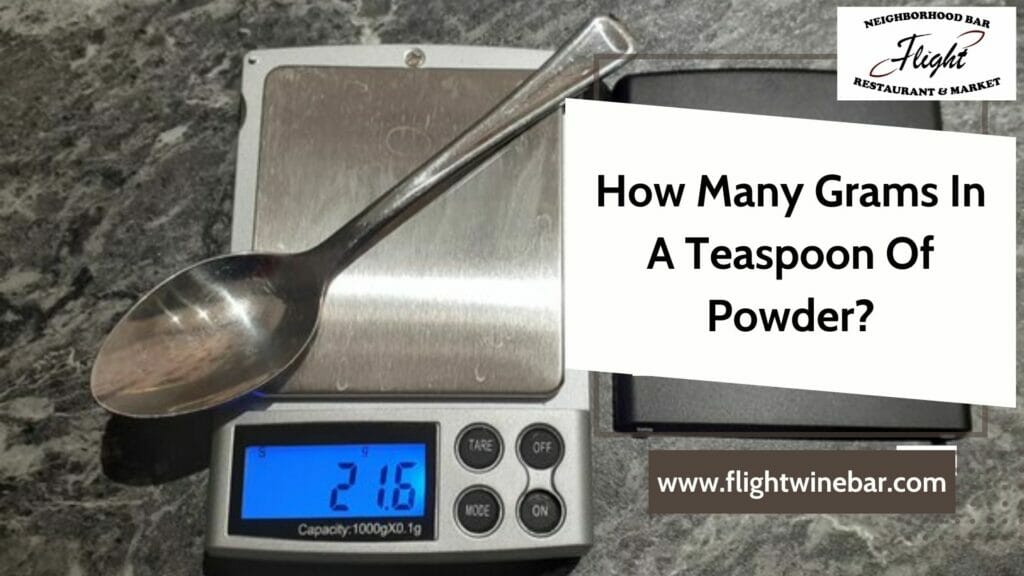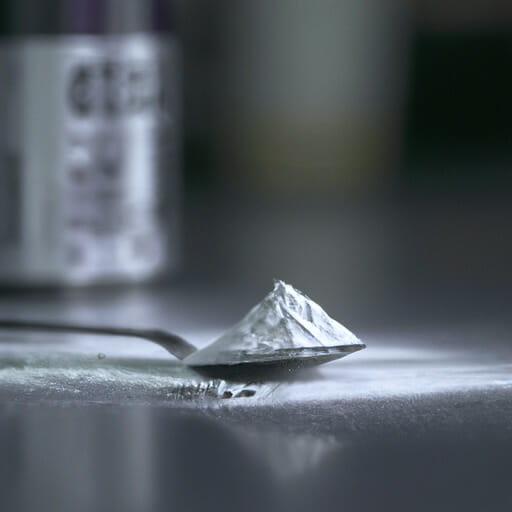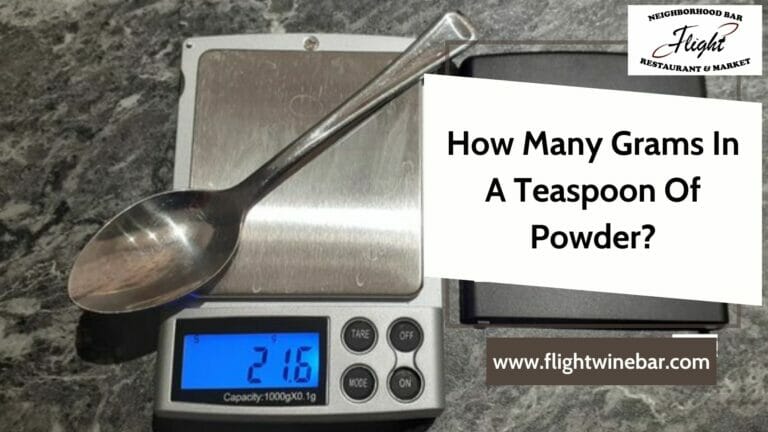A teaspoon of powder is a common measurement used in cooking and baking. But how many grams are in a teaspoon of powder? This is an important question to answer when measuring out ingredients for recipes. In this article, we will discuss the answer to this question and provide some helpful tips for measuring out powder accurately.

What Is the Standard Measurement for a Teaspoon of Powder?
Contents
- 1 What Is the Standard Measurement for a Teaspoon of Powder?
- 2 How to Measure Out the Right Amount of Powder for Your Recipe
- 3 What Are the Different Types of Powders and How Much Do They Weigh?
- 4 How to Convert Grams to Teaspoons for Accurate Measurement
- 5 What Are the Benefits of Using a Teaspoon of Powder in Your Recipes?
- 6 How to Store Powders to Ensure Maximum Freshness and Flavor
- 7 What Are the Different Uses for Powders in Cooking and Baking?
- 8 How to Measure Out the Right Amount of Powder for Your Specific Recipe Needs
- 9 FAQs:
- 10 1. How many grams are in a teaspoon of powder?
- 11 2. How much does a teaspoon of baking powder weigh?
- 12 3. How much does a teaspoon of sugar weigh?
- 13 4. How much does a teaspoon of flour weigh?
- 14 5. How much does a teaspoon of cocoa powder weigh?
- 15 6. How much does a teaspoon of cornstarch weigh?
- 16 7. How much does a teaspoon of baking soda weigh?
- 17 8. How much does a teaspoon of salt weigh?
- 18 Conclusion
A teaspoon of powder is typically measured as 5 milliliters (mL). This is equivalent to about 1/3 of a tablespoon. When measuring out powder, it is important to use a measuring spoon to ensure accuracy. A teaspoon of powder can be used for a variety of purposes, such as adding flavor to a dish or adding a supplement to a smoothie. Measuring out a teaspoon of powder can be a great way to ensure that you are getting the right amount of flavor or supplement for your needs.
How to Measure Out the Right Amount of Powder for Your Recipe
Measuring out the right amount of powder for your recipe is an important step in ensuring that your dish turns out just right! Here are some tips to help you get it right every time:
1. Use a kitchen scale. A kitchen scale is the most accurate way to measure out the right amount of powder for your recipe. Place the bowl or container you’ll be using on the scale and zero it out. Then, add the powder until you reach the desired weight.
2. Use measuring spoons. If you don’t have a kitchen scale, measuring spoons are the next best option. Make sure to use level spoons and fill them to the top.
3. Use measuring cups. If you’re measuring out a large amount of powder, measuring cups are the way to go. Again, make sure to fill them to the top and level them off.
4. Use a sifter. If you’re measuring out a fine powder, like flour or cocoa powder, use a sifter to make sure you get an accurate measurement.
Measuring out the right amount of powder for your recipe is an important step in ensuring that your dish turns out just right! With these tips, you’ll be able to measure out the perfect amount of powder every time. Happy cooking!
What Are the Different Types of Powders and How Much Do They Weigh?
Powders come in a variety of shapes and sizes, and each type has its own unique weight. Here’s a quick overview of the different types of powders and how much they weigh:
• Flour: Flour is a fine powder made from grains, nuts, or seeds. It typically weighs around 454 grams per pound.
• Sugar: Sugar is a sweet, granulated powder made from sugar cane or sugar beets. It typically weighs around 793 grams per pound.
• Baking Powder: Baking powder is a dry, leavening agent used in baking. It typically weighs around 454 grams per pound.
• Cocoa Powder: Cocoa powder is a dry powder made from cocoa beans. It typically weighs around 567 grams per pound.
• Cornstarch: Cornstarch is a fine, white powder made from corn. It typically weighs around 454 grams per pound.
• Cornmeal: Cornmeal is a coarse powder made from ground corn. It typically weighs around 454 grams per pound.
• Spices: Spices are dried, ground plant parts used to flavor food. They typically weigh around 454 grams per pound.
No matter what type of powder you’re using, it’s important to measure it accurately to ensure the best results. With the right measurements, you can create delicious dishes and baked goods that are sure to please!
How to Convert Grams to Teaspoons for Accurate Measurement
Measuring ingredients accurately is essential for successful baking and cooking. If you’re used to measuring ingredients in teaspoons, but the recipe you’re using calls for grams, don’t worry! Converting grams to teaspoons is easy and can help you get the perfect results every time.
To convert grams to teaspoons, you’ll need to know the density of the ingredient you’re measuring. Different ingredients have different densities, so it’s important to look up the density of the specific ingredient you’re using. Once you know the density, you can use the following formula to convert grams to teaspoons:
Number of teaspoons = weight in grams / density of ingredient x 5
For example, if you’re measuring sugar, which has a density of 0.5, and you have 10 grams of sugar, you would use the following formula:
Number of teaspoons = 10 / 0.5 x 5 = 10 teaspoons
It’s important to note that this formula is only an approximation. Different brands of ingredients may have slightly different densities, so it’s always best to double-check your measurements.
Now that you know how to convert grams to teaspoons, you can measure ingredients accurately and get perfect results every time!
What Are the Benefits of Using a Teaspoon of Powder in Your Recipes?
Cooking with a teaspoon of powder can be a great way to add flavor and texture to your recipes! Here are some of the benefits of using a teaspoon of powder in your recipes:
1. Variety: A teaspoon of powder can add a variety of flavors to your recipes. From savory to sweet, you can find a powder to suit any dish.
2. Versatility: Powders can be used in a variety of ways. You can sprinkle them on top of dishes, mix them into sauces, or even use them as a coating for meats and vegetables.
3. Nutritional Value: Powders are often packed with vitamins and minerals, making them a great way to add extra nutrition to your meals.
4. Cost-Effective: Powders are usually much cheaper than other ingredients, making them a great way to save money while still adding flavor to your recipes.
Using a teaspoon of powder in your recipes can be a great way to add flavor and nutrition to your meals. So why not give it a try?
How to Store Powders to Ensure Maximum Freshness and Flavor
Storing powders correctly is essential for ensuring maximum freshness and flavor. Here are some tips to help you store your powders properly:
1. Keep powders away from heat and light. Heat and light can cause powders to lose their flavor and freshness. Store them in a cool, dark place, such as a pantry or cupboard.
2. Store powders in airtight containers. This will help keep out moisture and prevent the powder from clumping.
3. Label your containers. This will help you keep track of when you purchased the powder and how long it has been stored.
4. Check expiration dates. Make sure to check the expiration date on the package before using the powder.
5. Use the powder within a reasonable amount of time. Powders can lose their flavor and freshness over time, so it’s best to use them within a few months of purchase.
By following these tips, you can ensure that your powders stay fresh and flavorful for as long as possible. Enjoy!
What Are the Different Uses for Powders in Cooking and Baking?
Cooking and baking with powders can be a great way to add flavor, texture, and nutrition to your dishes. From savory to sweet, there are a variety of uses for powders in the kitchen. Here are some of the most common uses for powders in cooking and baking:
1. Thickening sauces and gravies: Powdered starches, such as cornstarch, arrowroot, and tapioca, are great for thickening sauces and gravies. Simply mix the powder with a small amount of cold water and then add it to the hot liquid.
2. Making breads and pastries: Powdered sugar is a key ingredient in many breads and pastries. It adds sweetness and helps to create a light, fluffy texture.
3. Flavoring dishes: Spices and herbs can be used in powdered form to add flavor to dishes. Powdered garlic, onion, and chili peppers are great for adding a kick to savory dishes.
4. Adding nutrition: Powdered superfoods, such as spirulina, chlorella, and wheatgrass, are a great way to add nutrition to your dishes. They can be added to smoothies, soups, and other dishes for a boost of vitamins and minerals.
5. Making desserts: Powdered sugar is a key ingredient in many desserts, such as cakes, cookies, and frostings. Cocoa powder is also a great way to add a rich, chocolatey flavor to desserts.
These are just a few of the many uses for powders in cooking and baking. With a little creativity, you can find many more ways to use powders in the kitchen.
How to Measure Out the Right Amount of Powder for Your Specific Recipe Needs
Measuring out the right amount of powder for your recipe can be a tricky task, but it doesn’t have to be! With a few simple tips, you can make sure you get the perfect amount of powder for your recipe every time.
First, make sure you have the right measuring tools. A kitchen scale is the most accurate way to measure out powder, but if you don’t have one, you can use measuring spoons or cups. Just make sure you use the same measuring tool for all of your ingredients.
Next, read the recipe carefully and make sure you understand the measurements. If the recipe calls for a teaspoon of powder, make sure you measure out a teaspoon, not a tablespoon.
Finally, when measuring out the powder, make sure you don’t pack it down. If you pack it down, you’ll end up with too much powder in your recipe. Instead, lightly spoon the powder into the measuring tool and level it off with a knife or spoon.
With these tips, you’ll be able to measure out the perfect amount of powder for your recipe every time!
FAQs:
1. How many grams are in a teaspoon of powder?
A teaspoon of powder typically weighs between 2 and 4 grams, depending on the type of powder.
2. How much does a teaspoon of baking powder weigh?
A teaspoon of baking powder typically weighs between 2 and 4 grams.
3. How much does a teaspoon of sugar weigh?
A teaspoon of sugar typically weighs between 4 and 5 grams.
4. How much does a teaspoon of flour weigh?
A teaspoon of flour typically weighs between 2 and 3 grams.
5. How much does a teaspoon of cocoa powder weigh?
A teaspoon of cocoa powder typically weighs between 2 and 3 grams.
6. How much does a teaspoon of cornstarch weigh?
A teaspoon of cornstarch typically weighs between 2 and 3 grams.
7. How much does a teaspoon of baking soda weigh?
A teaspoon of baking soda typically weighs between 2 and 3 grams.
8. How much does a teaspoon of salt weigh?
A teaspoon of salt typically weighs between 4 and 5 grams.
Conclusion
In conclusion, the answer to the question of how many grams in a teaspoon of powder depends on the type of powder and its density. Generally, a teaspoon of powder can range from 2 to 5 grams, but it is important to check the specific measurements for the powder in question.







